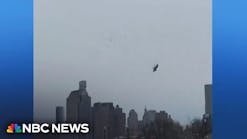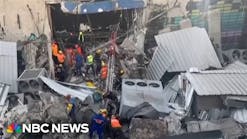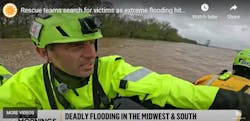Most emergency responders are familiar with the National Transportation Safety Board (NTSB), which is charged with investigating transportation incidents in this country to increase safety in all modes of transportation. Whenever an accident occurs involving aircraft, trains, buses or other modes of mass transportation, the NTSB is quick to mobilize and arrive on the scene to start investigating the cause.
Recent legislation passed by Congress has identified the NTSB as the lead agency for aircraft accident investigations. The NTSB's jurisdiction, however, is limited to transportation accidents. When a propane rail car exploded in Kingman, AZ, 25 years ago, killing 11 firefighters and one civilian, the NTSB responded, but could not investigate because the tank was on a rail siding and not in transit (see Firehouse®, July 1998).
Emergency officials repeatedly urged the creation of a similar federal agency to investigate accidents involving chemicals in transportation, storage and use. The first steps were taken in 1990, when Congress attached amendments to Public Law 101-549, the Clean Air Act, authorizing the creation of an independent federal agency to concentrate on the investigation of chemical accidents. The U.S. Chemical Safety and Hazard Investigation Board (CSB) was born.
After several years of growing pains as well as attempts by the Clinton Administration to eliminate it through budget cuts, the CSB began operations on Jan. 5, 1998. It has already been involved in more than 15 chemical accidents, including a propane explosion in Iowa that killed two volunteer firefighters.
The board's mission is to "work in concert with industry, labor, government and communities to help prevent accidents" involving chemicals. This mission is to be accomplished by:
- Investigating and issuing reports on causes of chemical accidents.
- Assessing the effectiveness of federal agencies in preventing chemical accidents.
- Eliminating duplication of efforts at the federal level concerning chemical accident investigation and prevention.
- Conducting special studies.
- Providing the findings of investigations and research to industry to improve safety of operations.
Further, the board has been charged by Congress with providing an independent evaluation of chemical accident causes, advancing approaches for mitigating the problems, and describing means to consolidate and curtail costs of the government's accident investigation operations. Congress has further mandated that the board investigate or cause to be investigated any and all accidental releases of any toxic or hazardous chemical resulting in a fatality, serious injury or substantial property damage.
Reports to the U.S. Environmental Protection Agency's Resource Conser-vation and Recovery Information System (RCRIS) have indicated that there are "278,755 facilities that generate, transport, treat, store and/or dispose of regulated hazardous waste." Additionally, the NTSB reports that "about four billion tons of regulated hazardous materials are shipped each year with more than 250,000 shipments of hazardous materials entering into the transportation system daily."
Bhopal A "Wake-Up Call"
In 1984, an accident occurred in Bhopal, India, that was a "wake-up call" for the world in terms of illustrating the devastation that chemicals can cause when released into the environment. More than 3,000 people died when methyl isocyanate was released from a chemical plant.
Many chemicals have the potential to cause a catastrophe, not only to industry workers, but to surrounding communities. Taking a proactive approach can have a positive outcome in preventing these types of disasters before they occur.
In 1989, Congress searched the federal system to find any existing federal resources to deal with chemical accidents. A Senate report concluded, "Based on...review of the record with respect to chemical accidents and the measures that various federal agencies, states and other nations are taking to respond to chemical accidents, several conclusions are warranted... Accident prevention has great promise, but is not given sufficient attention in current federal programs...No agency of the United States government is actively engaged in efforts to prevent chemical accidents, today."
Fourteen federal agencies were actively involved in accident prevention at that time, so Congress further identified a need to "...improve the effectiveness of accident prevention programs and reduce the burden of duplicative requirements of regulated entities."
Industry representatives voiced support for the concepts in congressional hearings. After evaluating alternatives, Congress concluded there was a need to determine the causes of chemical accidents and identify solutions for prevention of future incidents. Congress determined that the best way to accomplish this task would be through the establishment of a national chemical safety and hazard investigation board. Thus, the CSB was authorized.
Initial Operations
During the board's first year of operation, due to limited funding, its staff will include five board members, one senior advisor, four special assistants, five technical professionals and four secretaries/administrative assistants.
The CSB is headed by Paul Hill Jr., Ph.D. Hill brings many years of chemical experience to the board, having headed the National Institute of Chemical Studies (NICS), which was a nonprofit organization with a mission of public education, emergency preparedness, community safety, pollution prevention, hazard identification, risk reduction, and risk communication concerning toxic and hazardous chemicals.
Gerald V. Poje, Ph.D., a board member, specializes in policy for toxicology and chemical hazards. His background includes directing the National Institute of Environmental Health Sciences. Phyllis G. Thompson, Ph.D., is a special policy assistant for the board. I worked with Thompson during her tenure with the Federal Emer-gency Management Agency (FEMA) as the technical training officer for the Chemical Stockpile Emergency Pre-paredness Program (CSEPP), which dealt with training issues for the Army's disposal of U.S. stockpiles of chemical weapons. During that time, I was impressed with her knowledge of training and chemical safety issues along with her dedication to FEMA and the CSEPP program.
Christopher W. Warner is a special assistant for legal operations. Warner, a lawyer, is a former advisor to the Interior Department. He will be the general counsel for the board.
Phillip S. Cogan is a special assistant for external relations. He is a former print and broadcast journalist and was the lead public affairs officer for 88 presidential disaster declarations. The office of external affairs will provide intergovernmental relations, act as a liaison with Congress, prepare publications and be the source of public information concerning the board's activities.
How To Report Incidents
All chemical accidents resulting in deaths, serious injuries or significant property damage should be reported to the CSB. If such a chemical release occurs, the National Response Center (NRC) must be notified at its toll-free number, 800-424-8802. The center is operated 24 hours a day, 365 days a year, by the U.S. Coast Guard.
In addition to being the contact point for the Chemical Safety and Hazard Investigation Board, the NRC receives reports of other types of chemical releases required under various federal laws and regulations. The NRC should also be notified if response organizations want to take part in the Environmental Protection Agency's reimbursement program for local expenses incurred at a chemical emergency.
Certain covered expenses may be reimbursed up to $25,000 if the NRC is notified within 24 hours of the time incident occurred. However, in reality, expenses incurred before the telephone call are not covered, so the call should be made early in the incident to insure eligibility for reimbursement. Before jurisdictions can seek reimbursement from the EPA, the NRC must have been called during the incident and all other efforts at collection from those responsible for the spill have been exhausted.
Since the beginning of operations, the CSB has investigated or reviewed more than 15 chemical incidents, of which six have been full investigations. The board has reviewed the other nine incidents using information received from other federal agencies, along with state and local agencies, including law enforcement. These accidents have resulted in 26 deaths, including two volunteer firefighters, and at least 36 serious injuries.
Incidents investigated have occurred in 13 states: Arizona, Arkansas, California, Florida, Idaho, Iowa, Louisiana (two), Nevada, New Jersey (two), New York, Ohio, Oregon, and Washington State. More than 90 incidents have occurred since January 1998, when the board began operations, that meet its investigative mandate. However, its resources have been exhausted already on the incidents in which it has been involved. The primary concentration at this point has been restricted to accidents involving fatalities.
Investigations Begin
The paint was hardly dry on the CSB's door signs when it was plunged into its first investigation on Jan. 7, 1998. An explosion at the Sierra Chemical Company near Reno, NV, killed four workers and injured three others. Sierra Chemical manufactures explosives for mining operations.
Two explosions occurred in a building used to manufacture boosters. Falling debris from those blasts triggered a third explosion involving an explosives-storage building at the south end of the company site. The cause of the initial blasts is believed to be from a worker leaving materials in a mixing pot overnight. The following morning, another worker turned on the pot and its blade hit some solidified explosive material, triggering an electric shock wave that initiated the explosion.
Board findings of circumstances that attributed to the tragedy included a lack of worker training, poor regulatory oversight and deficiencies in safety procedures at the facility. The final report is still pending at this time.
The sequence of events that takes place when the CSB is called upon to investigate an accident includes sending personnel to the scene to interview people and collect physical evidence, holding a board of inquiry, holding public hearings and issuing a final report.
On March 4, 1998, four workers were killed at Sonat Exploration, an oil-separation facility near Pitkin, LA. Another incident occurred on March 27, 1998, at the Quest Aerospace facility near Yuma, AZ, where toy-rocket motors are manufactured. The explosion killed four workers. On the same day, a confined space accident occurred at a Union Carbide plant in Hahnville, LA. One worker was killed and another seriously injured. Nine workers were injured during a fire on April 8, 1998, at the Morton Specialty Chemical Company in Paterson, NJ.
Two volunteer firefighters were killed on April 8, 1998, in a propane explosion on a poultry farm in Albert City, IA, northwest of the capital city of Des Moines. Seven others, including a deputy sheriff, were injured in the explosion. A pipe connected to a large propane storage tank was broken by children riding four-wheel all-terrain vehicles. The leaking propane found an ignition source and ignited. Eventually, a BLEVE (boiling liquid expanding vapor explosion) occurred in the propane tank as a result of direct flame impingement from the burning propane.
In addition to the investigation by the CSB, the National Institutes for Occupational Safety and Health (NIOSH) investigated the accident. NIOSH has been directed by Congress to investigate all firefighter line-of-duty deaths and develop recommendations to prevent future injuries and deaths. The final report on the Albert City explosion is pending. Other incidents also are under review by the CSB.
In early September 1998, an incident occurred involving liquid nitrogen, a cryogenic liquid that presents an asphyxiation hazard in addition to being very cold. The accident occurred while two workers were working on an oil pipeline in Springer, OK. They had been using liquid nitrogen in a pit to pressure check the pipeline and (in the opinion of the author) were likely to have been asphyxiated by the nitrogen displacing the oxygen in the pit. When discovered, both men were frozen by the very cold nitrogen, which has a liquid boiling point of 320 degrees below zero Fahrenheit; the vapors being released by the liquid would also have been very cold.
No final reports are available from any of the CSB's full investigations or incident reviews. Progress on these investigations can be followed on the CSB Web site (www.chemsafety.gov) or by calling the CSB office of external affairs at 202-261-7600. The mailing address for the CSB is U.S. Chemical Safety and Hazard Investigation Board, 2175 K. Street N.W., Suite 400, Washington, D.C. 20037-1809. Its fax number is 202-261-7650.
While there certainly appears to be a legitimate function and identified need for the CSB, it is severely hampered in its investigative efforts because of limited resources. For the CSB staff members to become as effective as their NTSB counterparts, Congress and the Clinton Administration will have to provide adequate funding for this board. Investigations need to occur quickly after an accident to insure useful results.
Robert Burke, a Firehouse® contributing editor, is the fire marshal for the University of Maryland and has served on state and county hazmat response teams. Burke is a veteran of over 16 years in career and volunteer fire departments, serving as assistant chief and deputy state fire marshal. He holds an associate's degree in fire protection technology and a bachelor's degree in fire science, and is pursuing a master's degree in public administration. Burke is an adjunct instructor at the National Fire Academy and Maryland Fire and Rescue Institute, and is the author of the textbooks Hazardous Materials Chemistry For Emergency Responders, published in 1997, and Counter-Terrorism for Emer-gency Responders, to be published in 1999. He can be reached on the Internet at [email protected].




